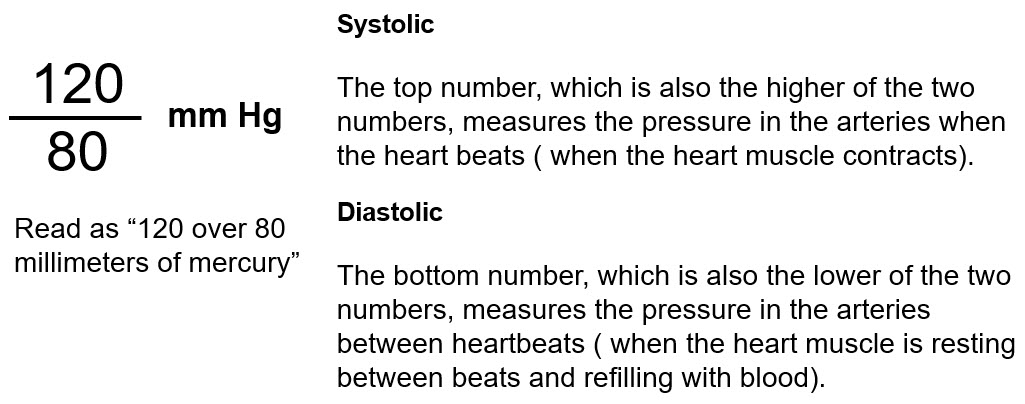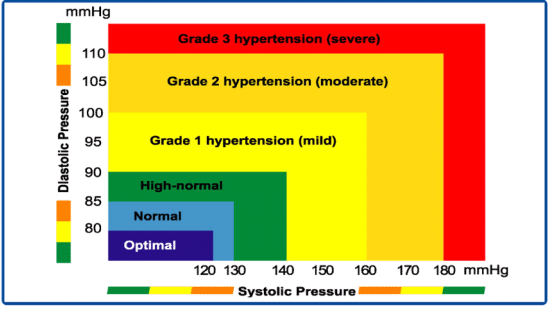Blood pressure refers to the exerted force by circulating blood on the walls of one’s blood vessels. Blood pressure is generally referring to arterial pressure, meaning, the pressure in one’s larger arteries (the blood vessels which take blood away from one’s heart). Abnormal blood pressure can lead to many unwanted occurrences, this article explains how you can monitor and control your own blood pressure.
What Is Normal Blood Pressure Reading?
The blood pressure considered normal is defined as 120/80, although the actual number varies depending on age and gender, and the exact “normal” level has changed over the course of many years.

Which Number Is More Important, Top or Bottom?
Generally speaking, the top number is more important because a high systolic reading is often associated with an increased risk of developing cardiovascular disease for those over the age of 50. Most people will experience a rise in systolic pressure as they grow older due to cumulative stiffness of larger arteries, increased occasions of vascular and cardiac disease, as well as prolonged accumulation of plaque.
What Is the Normal Blood Pressure Reading According to My Age?
Research has clearly shown a correlation between age and rising blood pressure. This rise is thought to occur to accommodate the need for increased amounts of oxygen and nutrients. For many decades, the assumption that one’s systolic pressure can be calculated by adding one’s age to 100 for men and subtracting 10 for women. For example, a man aged 45 would likely have a systolic blood pressure of 145.
See the table below featuring the average normal blood pressure for different ages.
Blood Pressure Range Charts by Age
|
Age |
Systolic BP |
Diastolic BP |
|---|---|---|
|
11-13 |
126 |
82 |
|
14-16 |
136 |
86 |
|
17-19 |
120 |
85 |
|
20-24 |
120 |
79 |
|
25-29 |
121 |
80 |
|
30-34 |
122 |
81 |
|
35-39 |
123 |
82 |
|
40-44 |
125 |
83 |
|
45-49 |
127 |
84 |
|
50-54 |
129 |
85 |
|
55-59 |
131 |
86 |
|
60+ |
134 |
87 |
For Children
|
Age |
Boys (mmHg) |
Girls (mmHg) |
|---|---|---|
|
1-3 |
80/34 - 120/75 |
83/38 – 117/76 |
|
4-6 |
88/47 – 128/84 |
88/50 – 122/83 |
|
7-10 |
92/53 – 130/90 |
93/55 – 129/88 |
What Is Considered a High Blood Pressure?
If your blood pressure has been recorded at 140/90 or higher on two separate occasions, then you would be considered to have high blood pressure. Once such an instance has been determined, you will likely be advised to continue to monitor your blood pressure at home throughout the day. If your blood pressure remains high even whilst resting, and does not return to what can be considered normal blood pressure, then your doctor will likely suggest certain lifestyle changes to combat the problem, such as exercise and diet changes, as well as medications.

How to Monitor My Blood Pressure?
Watch the video below to learn how to monitor your own blood pressure at home, and how to work with your doctor on the results.
- Make sure the cuff fits. One should first measure around one’s upper arm and ensure to buy the correct device with a suitably sized cuff.
- Remain still. Ensure to sit still whilst measuring your blood pressure, and try not to smoke, exercise, or drink caffeine within thirty minutes before taking a reading.
- Sit correctly. Sit with your back straight and your feet flat on the floor. Sit on a dining chair to provide support for your back. Use a flat surface to support your arm. Ensure to read the instructions and use the product effectively.
- Take numerous readings. When monitoring one’s blood pressure, it would be wise to take more than one measurement. One should take two to three measurements around several minutes apart and record all of the results accurately.
- Take readings at the same time each day. Such as in the mornings and evenings, or whenever your doctor advises.
- Consult your doctor if you have numerous high readings. One high reading should be no cause for concern, consistent high readings should be met with medical assistance.
How Can I Control My Blood Pressure?
There are numerous changes one can make to their lifestyle to help decrease high blood pressure. These include:
- Maintaining a healthy weight. Those who are overweight or obese have a higher risk of high blood pressure.
- Exercise regularly. Exercising moderately everyday can help to lower the risk of developing high blood pressure, always check with your doctor beforehand to ensure that your exercise schedule is not too strenuous.
- Eat healthily. Ensuring to consume a well-balanced diet consisting of many fruits, vegetables, and whole grains, which can help to lower the risk of developing high blood pressure.
- Reduce sodium consumption. Those who eat a lot of processed foods are generally consuming too much sodium, as processed foods are filled with added salt. A diet low in salt can help to reduce blood pressure and restore normal blood pressure levels.
- Drink less alcoholic beverages. Alcohol consumption can increase blood pressure, meaning that drinking less alcohol can be beneficial.
- Do not smoke. Smoking seriously increases the risk of developing high blood pressure as well as lung cancer, heart disease, stroke, and other health concerns. Try to quit if you are a smoker.
